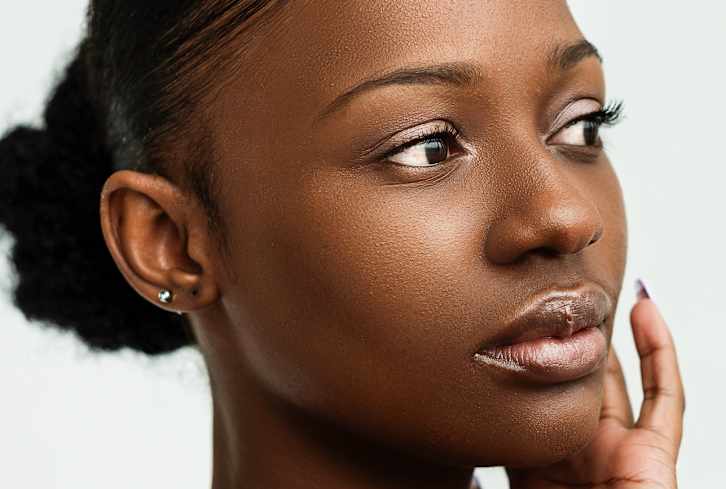Advertisement
8 At-Home, All-Natural Remedies For Dry & Damaged Hair

Between dye jobs, hot tools, and skipping those much-needed routine trims, our strands can really take a beating. And then there's the stuff outside our control: pollution, sun damage, and just daily wear-and-tear that we can't avoid. Split ends, dry texture, and just straight-up damage can make styling your hair a real challenge. And while some experts say the best way to get rid of extreme damage is to cut it and start over, most of us are willing to try everything under the sun before pulling out the scissors.
And that's where we are here to help: Here's your all-inclusive guide to reversing dry, damaged hair with easy-to-do natural remedies you can do at home:
Pre-shampoo with coconut oil.
If you're experiencing dull and dry hair, you're probably in need of a heavy dose of moisture. Coconut oil is a tried-and-true hydrator that we all know and love for a variety of reasons including makeup removal, body hydration, and even lip balm. But this oil works wonders on our hair, too. When applied before shampooing, it helps prevent the hair from soaking up too much water. This not only will help keep dryness at bay, but it stops the strand from swelling too much, which can lead to cuticle damage over time1.
Simply apply to the shaft of the hair and leave on for 20 to 30 minutes before shampooing and conditioning as usual. Remember: The most important step when using coconut oil is to thoroughly shampoo afterward. Even though the oil may seem lightweight, leaving it in the hair can cause greasy, weighed-down strands, which can turn into additional damage in the long run. So, in short, don't skip the shampoo.
Rinse with cold water.
You may have heard a professional stylist talk about cold water rinses for shiny, lustrous locks, but according to New York City–based hairstylist Marshall Lin, it's a proven remedy to stop hair damage. "Cool water rinses help close and protect your scalp and hair's cuticle, which makes the hair stronger," he says. Since heat and humidity make the hair's cuticle rise2, cold water has the opposite effect. Just be sure to properly rinse out your strands: One study found that those who rinsed with cold water were more likely to have residue afterward, so be sure not to make that mistake.
His go-to method is to wet a towel with cold water and wrap it around the hair until the towel is no longer cool. Next, shampoo and condition your hair, rinsing with cold water, and gently comb hair from roots to ends. Finally, style hair as usual, and you'll find your hair is softer, shinier, and more hydrated.
Deep condition with olive oil.
Olive oil is full of anti-inflammatory properties3 that help promote scalp and follicle health4. Plus all those healthy fats, we know and love olive oil for for softening and conditioning our hair, according to Lin. Before you grab whatever bottle you find in your pantry, make sure you're using an extra-virgin oil to ensure the highest quality. Extra-virgin olive oil (EVOO) is only produced by pressing the olives, where other variations of the oils use chemicals and alternative processes to extract the oil. The simpler the process, the more vitamins and nutrients are retained.
The best part about EVOO is you can practically use it as you please. From adding it to a packaged deep treatment to using as treatment alone or a spot treatment for dry patches, the possibilities are endless.
Swap your leave-in for aloe vera.
Aloe vera is no new kid on the block when it comes to DIY treatments—its skin-healing and hair-helping qualities are near famous at this point. When it comes to hair, you can use aloe vera alone as a conditioner or create a DIY deep treatment that will really pack a punch of moisture and nourishment. Our favorite formula includes aloe vera gel, straight from an aloe leaf, of course; honey; and coconut oil. Mix all your ingredients and apply before shampooing for a deep treatment like you've never had before. But don't rush the process. You'll want to let this sit on your hair for at least 30 minutes before rinsing out, and it even works wonders on your scalp, too. Then follow-up with an aloe leave-in conditioner spray. You can find the full aloe vera conditioner and leave-in recipe here.
Warm up your own hot oil treatment.
Hot oil treatments have been around for a while and pack a punch of moisture and help to repair damage. And making a DIY hot oil treatment at home is way easier than you'd think. Simply measure out ½ to ¾ cup of oil. Suggested oils include coconut, almond, jojoba, and castor for best results. Next, you can use the microwave or stove to warm your oil, but make sure it doesn't boil. Once the oil is warm but still touchable, apply all over the hair and let sit for 30 minutes to an hour. Since this can get a bit messy, feel free to cover hair with a plastic shower cap or wrap in a warm towel. It creates steam, which opens up the hair cuticle, allowing the treatment to penetrate the hair shaft. Once your timer buzzes, shampoo, condition, and style hair as usual. Don't be alarmed if you notice a whole lotta shine and hydration to your locks.
Cleanse with potato flour shampoo.
Yes, really, says celebrity hairstylist and Beachwaver tool creator Sarah Potempa, who suggests we whip up a potato flour shampoo. We ask no questions. Well, sorta. Potempa recommends using this concoction once or twice a year works to restore dry, damaged hair. Potatoes are chock-full of vitamins and minerals including vitamin B, C, and iron5 that help to strengthen the hair strands and prevent hair loss and breakage. For Potempa's recipe, you'll need ¼ cup of potato flour, 2 cups of water, and 2 teaspoons of apple cider vinegar. Combine the flour and water in a saucepan, mix until smooth, and let the mixture warm on low heat for 15 minutes. Remove from the heat, add vinegar until combined, and let it cool before using. Once cooled, pour into a container and use in place of traditional shampoo, making sure to distribute on the scalp and length of the hair.
Use yogurt for moisture.
Dry hair can be quite a challenge to rehydrate. And so many factors can affect the moisture levels in the hair, from the weather to harsh styling products. To help fix any damage caused by dryness, reach for plain yogurt. The lactic acid in yogurt acts as a humectant, which helps slow down the loss of moisture in the hair. This treatment is best for frizzy and textured hair as it helps to smooth the hair follicle and keep moisture where you want it, in the hair. There's no recipe for this treatment; simply apply the plain yogurt all over the hair and let it sit for a minimum of 20 minutes. Shampoo, condition, and finish with a cool water rinse for mega shine.
Whisk eggs for protein.
It's no secret that eggs are a healthy source of protein. That sunshine-yellow yolk is rich in healthy fats and vitamins and is really moisturizing when applied to the hair. Not to mention the amino acids in eggs help to keep strands smooth, nourished, and even protected against sun damage and pollution. For dry hair, you'll want to use the entire egg, both the white and yolks, to hydrate and strengthen hair. For short hair, one egg should do the trick, and for longer hair, try whisking 2 to 3 eggs or until the entire hair is covered. Leave on the hair for 20 to 30 minutes and rinse with cool to warm water before shampooing. (The cool part is key: You can literally bake the eggs on your scalp if you use warm or hot water.) Since too much protein can be potentially damaging to the hair6, we don't recommend using this mask more than once or twice a month.
6 Sources
- https://journals.sagepub.com/doi/abs/10.1177/004051755202200702?journalCode=trjc
- https://www.ncbi.nlm.nih.gov/pmc/articles/PMC4387693/
- https://www.ncbi.nlm.nih.gov/pubmed/29141574
- https://www.ncbi.nlm.nih.gov/pmc/articles/PMC4462586/
- https://www.ncbi.nlm.nih.gov/pmc/articles/PMC3650512/
- https://www.ncbi.nlm.nih.gov/pmc/articles/PMC5315033/
Watch Next
Enjoy some of our favorite clips from classes
Enjoy some of our favorite clips from classes
What Is Meditation?
Mindfulness/Spirituality | Light Watkins
Box Breathing
Mindfulness/Spirituality | Gwen Dittmar
What Breathwork Can Address
Mindfulness/Spirituality | Gwen Dittmar
The 8 Limbs of Yoga - What is Asana?
Yoga | Caley Alyssa
Two Standing Postures to Open Up Tight Hips
Yoga | Caley Alyssa
How Plants Can Optimize Athletic Performance
Nutrition | Rich Roll
What to Eat Before a Workout
Nutrition | Rich Roll
How Ayurveda Helps Us Navigate Modern Life
Nutrition | Sahara Rose
Messages About Love & Relationships
Love & Relationships | Esther Perel
Love Languages
Love & Relationships | Esther Perel
What Is Meditation?
Box Breathing
What Breathwork Can Address
The 8 Limbs of Yoga - What is Asana?
Two Standing Postures to Open Up Tight Hips
How Plants Can Optimize Athletic Performance
What to Eat Before a Workout
How Ayurveda Helps Us Navigate Modern Life
Messages About Love & Relationships
Love Languages
Advertisement

We Need To Talk About Toxic Femininity In Beauty: Ever Encounter These Examples?
Perpetua Neo, DClinPsy

We Need To Talk About Toxic Femininity In Beauty: Ever Encounter These Examples?
Perpetua Neo, DClinPsy

We Need To Talk About Toxic Femininity In Beauty: Ever Encounter These Examples?
Perpetua Neo, DClinPsy

We Need To Talk About Toxic Femininity In Beauty: Ever Encounter These Examples?
Perpetua Neo, DClinPsy









